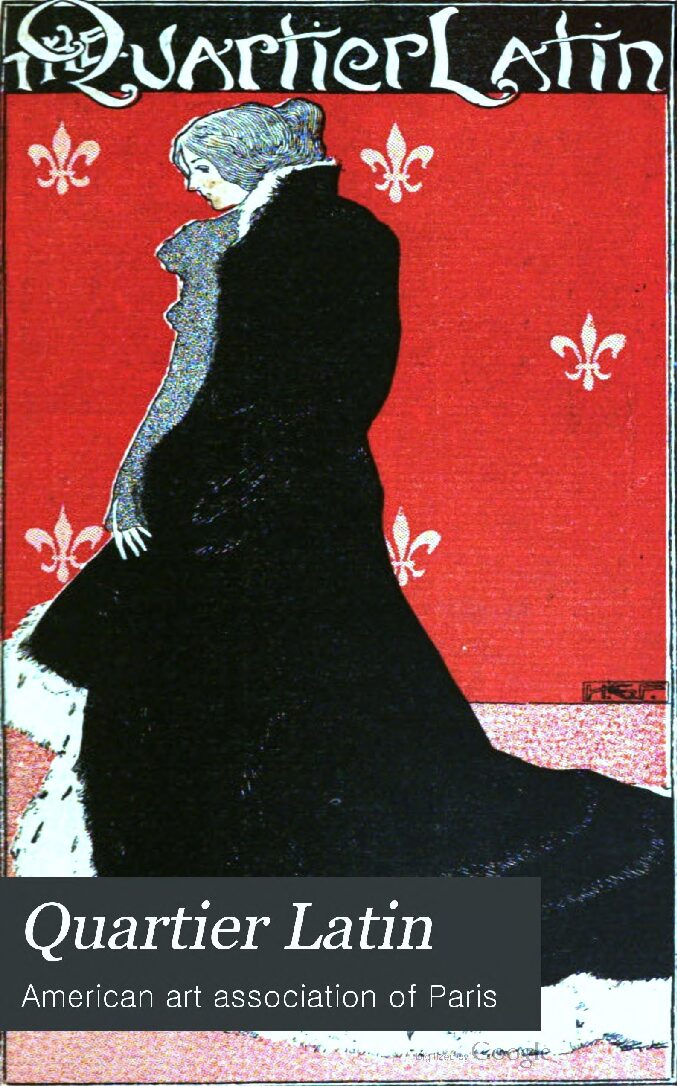Cover Art, Quartier Latin, Vol II January 1897 No. 6, Compiled monthly in Paris and printed and published by llifee & Son, of London, #30/p.176, p. 177
One of my worthy correspondents (more worthy than me since he, not I, discovered this little gem of a review) shared this essay on Seton’s Study in the Art Anatomy of Animals. Quartier Latin was a turn of the century (the previous century) English-language journal of Parisian art and literature. If all my readers would send items like this for the Seton website/blog, the editor and author of the blog/website would be saved much time and trouble of finding these things on his own.
About the Reviews That Follow
The review—glowing in a way most writers seldom receive—is followed by a second review. The first one is unattributed; the second identified only by initials. And as good as was the first, the second is even more enthusiastic. Both are presented in the original without editing.
For those unfamiliar with this work, Art Anatomy provided one hundred drawings of dogs, cats, bears, horses, and birds, showing the muscular and skeletal details of those animals for use by artists in creating their own illustrations. Additional technical notes followed on elephants, camels, and pigs. It was an extraordinary accomplishment for its time, and remains so, in my view, today.
Review the First
“THE ART ANATOMY OF ANIMALS.”
THIS long-expected work is at length out. The delay finds a ready pardon by those who know anything of the history of the book, for, designed at first by the author, Mr. Ernest E. Seton Thompson, to be a simple portfolio of a dozen plates, illustrating the anatomy of the dog, it has grown into an imperial quarto volume with fifty large plates treating of over fifty birds and beasts-making, in its finished state, a very complete and valuable text-book for the world of artists and art students. The work has called forth the strongest expression of admiration from MM. Gérôme, Fremiet, Morot, Duval, Briton Riviere, Lord Leighton, and many others. As M. Fremiet put it, the plates are as remarkable for the zoological and anatomical knowledge they show as they are for their artistic excellence, and the artist and scientist alike will find them of the greatest utility. The treatment is methodic throughout. The dog is selected as a type, and its anatomy thoroughly examined from the artist’s point of view, or, in the author’s own words, with regard to the “visible form of the living animal.” Particular stress is laid on the value of the hair in most mammals, and special plates are devoted to the influence of the bones in life. After the dog, the lion, tiger, horse, and about twenty- five other animals, are considered separately, and the text is accompanied by data of actual measurement, and by plates of proportions. A section is devoted to the movements of animals, numerous instantaneous photographs being used as illustrations. The last section treats of the bird. At first sight most artists consider that bird anatomy is quite outside their province; but after a careful study of these truly wonderful drawings, illustrating the yet more wonderful principles discovered by Mr. Thompson, they will agree with Fremiet, Gérôme, and others (who were at first disposed to ridicule so much attention bestowed on the minutiæ of bird and beast anatomy, such as the drawing of individual feathers) that this painstaking and thoroughness is, after all, both in practice and result, one of the truest forms of art. Perhaps these eminent gentlemen called to mind the fact that it is art of this sort that has made the great artists of Japan, as well as of Assyria and Egypt.
Review The Second
“THE ART ANATOMY OF ANIMALS”
We hope we violate no confidence in publishing the following letter, which speaks for itself:
Dear Mr. Editor, I am much obliged to you for so kindly letting me see, in advance, the review of my book. While it is very good as far as it goes, it is not, I think, nearly strong enough. I have always been a firm believer in the theory that an author should write his own review. Obviously he knows better than anyone else what the strong points of his work are, as well as when to be considerate and omit mention of any little slips or deficiencies. You are quite right in describing my work as “valuable,” “complete,” “conscientious,” etc. It certainly all of these, but why not come right out flat and call it, as you know it is, “great,” “magnificent,” “glorious.” As a matter of fact, if you had styled it “ the epoch-marking product of a colossal intellect,” I should have been the last man to call you to task. One or two of the critics proclaim it the best thing of its kind. As it is the only thing of its kind, these men are mistaken if they think they flatter me. I’m not hunting for a cheap boom, Mr. Editor; but if in your next number you repent, and do your full and proper duty as my reviewer, and really do speak out for the world of brains, and, in so doing, if you should chance to say any- thing about the author’s “god-like intellect,” “his ponderous intellect and superhuman sagacity,” or allude to possible “ Academic Crowns,” and “agitation to secure him the Legion of Honour, or a Government pension, etc., etc.-well, between you and me, it’ll be all right.
E. S. T.
P.S.-Enclosed please find P.0.0. to secure twenty-five copies of the issue in question.

